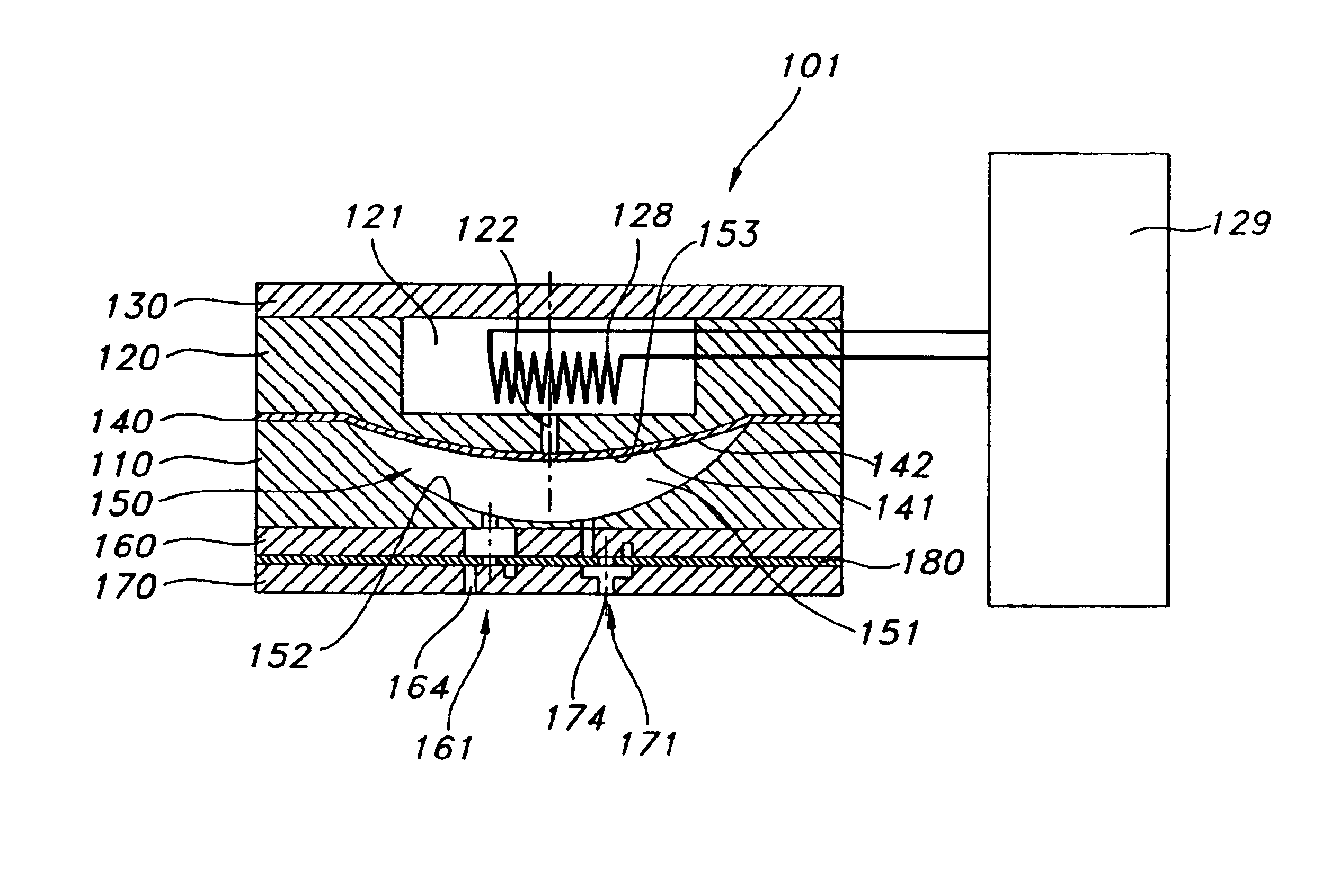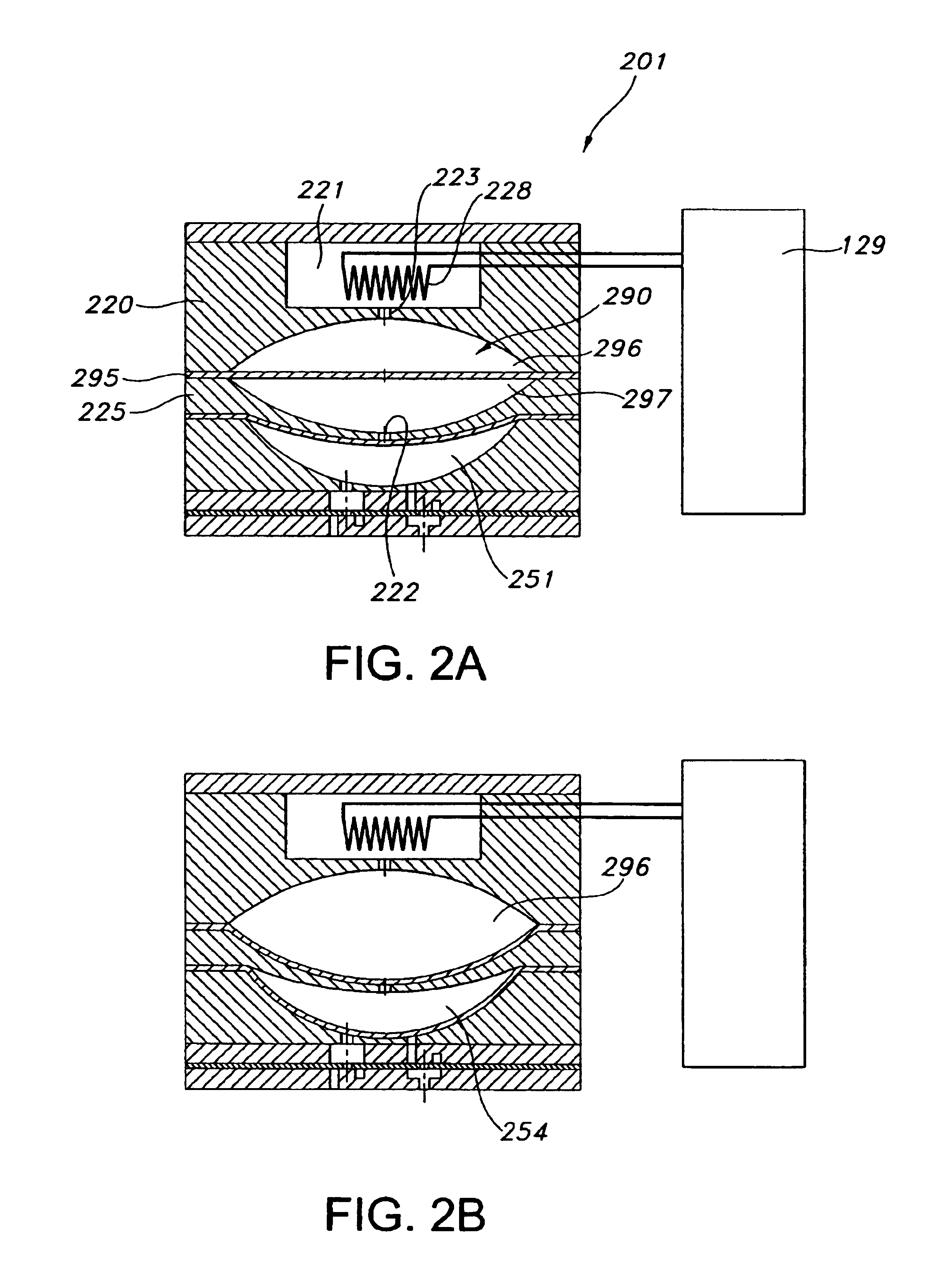Membrane pump with stretchable pump membrane
a membrane pump and membrane technology, applied in the field of membrane pumps, can solve the problems of increased pressure inside the pumping chamber, less suitable gas pumping, and opening of the outlet valv
- Summary
- Abstract
- Description
- Claims
- Application Information
AI Technical Summary
Benefits of technology
Problems solved by technology
Method used
Image
Examples
second embodiment
[0094]Next, with reference to FIGS. 2A and 2B, a pump 201 comprising a transmission cavity with a transmission membrane will be described.
[0095]In respect of the pump “as such” (i.e. the pump chamber, valves, fluid chamber and heating structure) the second embodiment corresponds in general to the first embodiment, however, the pump 201 comprises first and second intermediate housing portions 220, 225 instead of the single intermediate housing portion 120. A transmission cavity 290 is formed between concave wall portions 291, 292 of the first respective the second intermediate housing portions which in combination define the boundaries for the transmission cavity. Arranged between the first and second intermediate housing portions an elastic membrane forms a transmission membrane 295 dividing the transmission cavity in an upper inlet chamber 296 and a lower outlet chamber 297 sealed from each other by the transmission membrane. In the shown embodiment the inlet chamber has an initial...
third embodiment
[0097]Next, with reference to FIGS. 3A and 3B, a pump 301 will be described.
[0098]In respect of the pump “as such” (i.e. the pump chamber, valves, and fluid chamber) the third embodiment corresponds in general to the first embodiment, however, there are two differences. Firstly, the upper wall portion 353 defining the upper boundary for the pump cavity is substantially planar, the pump membrane thereby resting thereon in an un-stretched state. Secondly, the pump fluid is displaced from the pump chamber 321 by means of an actuator membrane 327 arranged between the upper and intermediate housing portions 330, 320. Corresponding to the fluid chamber the actuator membrane is provided with a disc-formed piezoelectric element 328 which can be shifted between a first generally planar configuration and a second downwardly curved configuration by control means 329.
[0099]The third embodiment may be provided either as an integral unit comprising both cavities, or as a system comprising a pump ...
fifth embodiment
[0105]With reference to FIG. 6, a pump 601 will be described, the pump essentially corresponding to the forth embodiment, however, the pump membrane comprises a passive electrode 602 whereas each of the opposed pump cavity walls are provided with a pair of “active” electrodes 603, 604 connected to the control means. In this way it will be possible to detect movement of the pump membrane relative to both of the wall portions providing improved control. The active electrodes 702, arranged either on the pump membrane 740 or a housing wall, may be configured as shown in FIG. 7, whereas the passive electrodes may be formed as a single disc-formed area, however, numerous configurations for the electrodes would be possible depending on the type of electrodes and the configuration of the control and detecting means.
PUM
 Login to View More
Login to View More Abstract
Description
Claims
Application Information
 Login to View More
Login to View More - R&D
- Intellectual Property
- Life Sciences
- Materials
- Tech Scout
- Unparalleled Data Quality
- Higher Quality Content
- 60% Fewer Hallucinations
Browse by: Latest US Patents, China's latest patents, Technical Efficacy Thesaurus, Application Domain, Technology Topic, Popular Technical Reports.
© 2025 PatSnap. All rights reserved.Legal|Privacy policy|Modern Slavery Act Transparency Statement|Sitemap|About US| Contact US: help@patsnap.com



